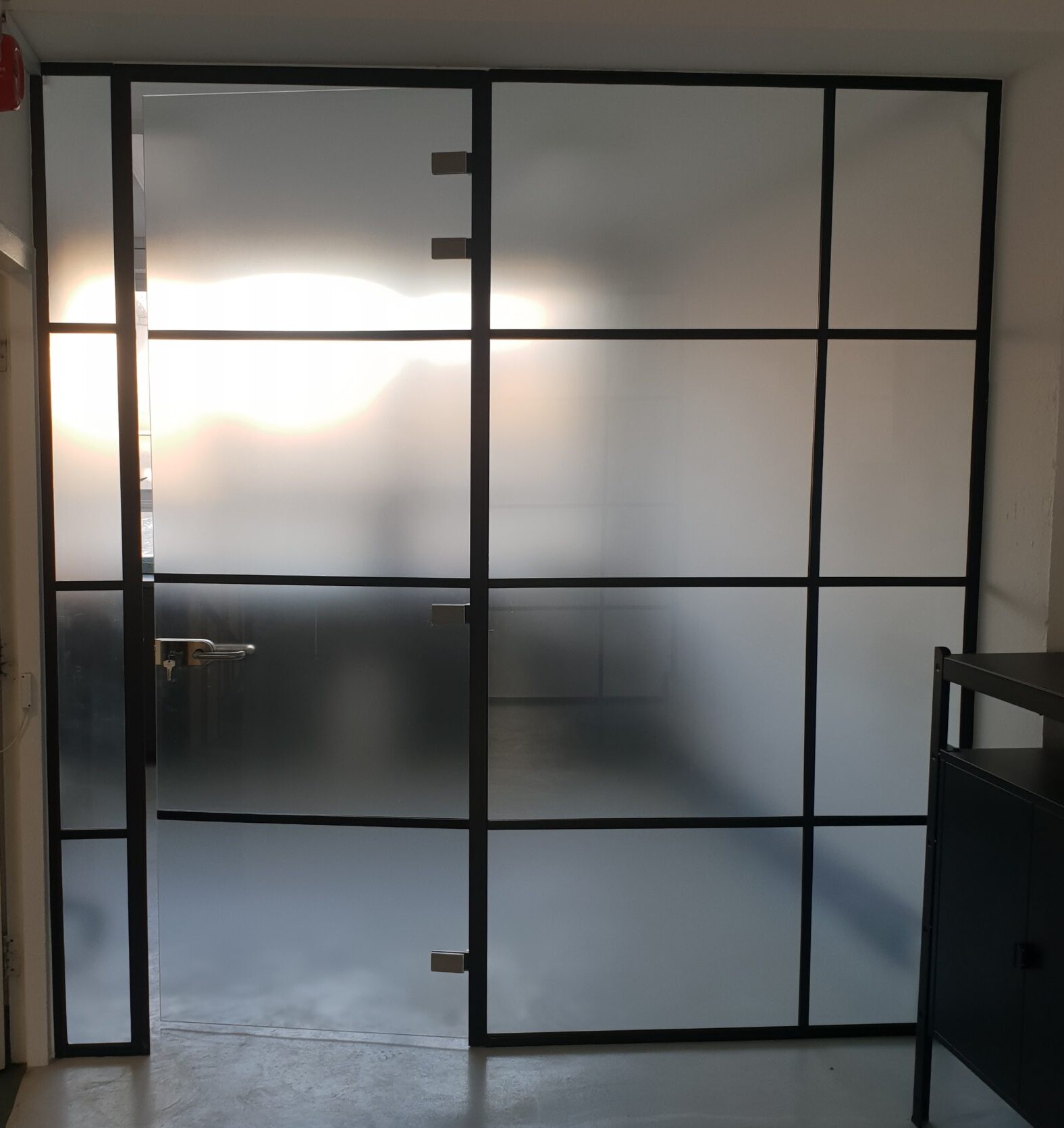
Obscure glass, sometimes called privacy glass, is a smart way to create private spaces without blocking out natural light. Its ability to combine function with design has made it a popular choice in modern offices, meeting rooms, and commercial interiors across the UK.
In this guide, we’ll explain what obscure glass is, the different types available, and where it works best. You’ll also learn how it compares to other privacy solutions and the key benefits it brings to workspaces and public buildings.
What Is Obscure Glass?
Obscure glass is a type of glass designed to limit visibility while still letting daylight pass through. Instead of offering a clear view like standard glass, it scatters or diffuses light, creating different levels of opacity that can range from softly blurred to almost fully opaque.
It is produced using one of the following methods:
1. Acid-etching: A chemical process that lightly corrodes the surface, giving it a smooth, satin-like finish that diffuses light evenly.
2. Sandblasting: Using high-pressure grit or sand to roughen the surface, producing a frosted effect with a slightly textured feel.
3. Patterned rolling: During manufacture, molten glass is passed through rollers engraved with designs such as ripples or geometric shapes, imprinting decorative patterns that scatter light and add visual character.
For commercial and high-traffic environments, obscure glass can also be toughened or laminated to meet UK safety standards, ensuring strength, durability, and compliance with building regulations. Because of this balance between discretion and brightness, it’s often referred to as privacy glass or sometimes frosted glass.
What are the Different Types of Obscure Glass?
Obscure glass comes in a range of finishes, each suited to different applications and design preferences:
1. Frosted Glass
2. Tinted gGass
3.Seeded Glass
4. Opaque Glass
5. Patterned Glass
6. Stained Glass
7. Cast Glass
8. Etched Glass
9. Textured Glass
Read More: Types of Obscure Glass
When comparing finishes, businesses can choose from a wide range of types of obscure glass finishes, depending on whether the focus is on design, noise reduction, or functionality.
Where Can Obscure Glass Be Used in Commercial Interiors?
The strength of obscure glass lies in its versatility across different sectors:
1. Office partitions & meeting rooms: Instead of solid walls, obscure glass panels keep spaces open and collaborative while ensuring confidentiality. A law firm, for example, may specify laminated obscure glass for acoustic privacy in client-facing rooms.
2. Reception areas & lobbies: Create subtle boundaries without making the space feel enclosed. Patterned obscure glass finishes often double as a design feature.
3. Hospitality & leisure: Restaurants and hotels use obscure glass in booths, bathrooms, and spa facilities where guests expect privacy without a dark, enclosed feel.
4. Healthcare & education: In hospitals or schools, obscure privacy glass windows offer protection while meeting hygiene and fire-safety standards.
5. Retail displays & fitting rooms: Blends visibility with security, allowing natural light to enhance displays while protecting restricted areas.
How Does Obscure Glass Compare to Other Privacy Solutions?
When planning interiors, businesses often compare obscure glass with other privacy options:
1. Obscure glass vs frosted glass: While frosted glass is one finish within the broader category of obscure glass. Obscure glass covers a wider variety of textures, patterns, and tints and even laminated acoustic panels, making it a versatile solution for offices, meeting rooms, and commercial spaces.
2. Obscure glass vs blinds or screens: Blinds and screens can block light and require ongoing maintenance. By contrast, obscure glass provides permanent privacy with natural daylight, reducing reliance on artificial lighting and offering a low-maintenance, modern finish.
3. Obscure glass vs tinted glass: Tinted glass reduces glare and heat but doesn’t deliver full privacy. Obscure glass achieves both, and when laminated, it can also enhance sound control in busy environments like conference rooms or hospitality venues.
What are the Main Benefits of Obscure Glass?
1. Privacy with natural light: Obscure glass creates privacy while still letting daylight through, unlike blinds or solid partitions. This makes it ideal for meeting rooms, offices, and healthcare spaces where confidentiality and brightness are equally important.
2. Modern and versatile design: Available in frosted, patterned, tinted, or laminated finishes, obscure glass can be tailored to suit any interior style. From office partitions to hospitality venues, it provides a sleek, professional look while aligning with brand identity.
3. Noise reduction: When laminated, obscure glass offers acoustic benefits as well as visual privacy. This is particularly valuable in open-plan offices, boardrooms, or high-traffic areas where controlling sound is just as important as reducing visibility.
4. Low maintenance: Durable and easy to clean, obscure glass avoids the hygiene issues of blinds or fabrics. It’s a long-term solution for commercial spaces like schools, hospitals, and restaurants where upkeep needs to be quick and cost-effective.
5. Added value: Beyond function, obscure glass enhances the professional image and long-term value of a property. Businesses benefit from a more polished, modern workspace that appeals to staff, clients, and investors.
What Should You Consider Before Installing Obscure Glass?
1. Thickness and durability requirements:
The right thickness depends on use. Obscure glass partitions in offices or meeting rooms must handle daily wear, while decorative privacy glass panels in receptions can be lighter. In high-traffic spaces like healthcare or education, laminated options offer extra durability and safety.
2. Safety and building regulations:
In the UK, glass in doors, partitions, or low-level glazing must meet strict safety standards. Toughened or laminated obscure glass is often required to reduce risks and comply with building codes.
3. Cost implications for custom finishes:
Standard frosted obscure glass is cost-effective, but upgrades like patterned or acoustic obscure glass increase investment. While bespoke designs or branding may raise costs, they add long-term value to commercial interiors. Planning early avoids budget surprises.
4. Professional installation vs DIY:
DIY fitting may work but won’t last long. Commercial obscure glass installations need professional expertise. Correct sealing and alignment ensure safety, durability, and compliance.
Final Thoughts
Obscure glass is more than just a privacy solution; it combines style, function, and durability in one material. Unlike blinds or partitions, it maintains natural light while creating discreet, comfortable spaces, making it ideal for offices, hospitality, and commercial interiors.
Its versatility is what makes it stand out: from patterned obscure glass panels that add design character to laminated options that improve sound control, it adapts to different spaces and needs. Businesses benefit not only from enhanced privacy but also from the modern, professional aesthetic it brings.
Choosing the right type and finish of obscure glass ensures your project achieves both performance and design goals, while also adding long-term value to your property.
FAQs
Yes, many suppliers offer etching or printing options for company branding.
Standard obscure glass offers some sound reduction, but laminated obscure glass is better for acoustic control.
No, it can be cleaned with regular glass cleaners, but abrasive materials should be avoided.
Yes, due to the finishing process, obscure glass is typically priced higher than standard clear glass.
Yes, it can be used for windows and façades, provided it meets local safety standards.














